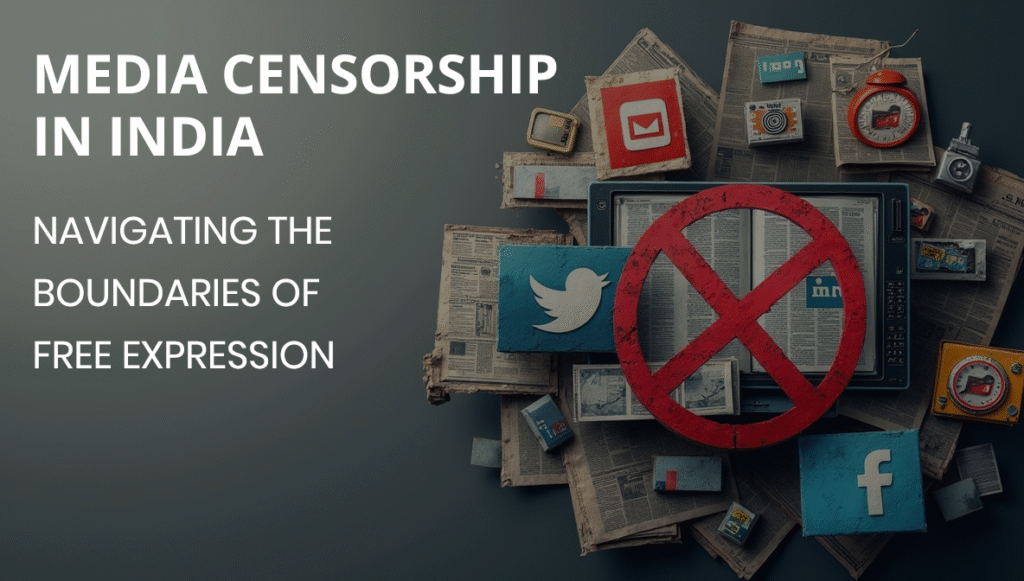
INTRODUCTION
Media censorship in India is one of the most debated issues in the democratic landscape. It revolves around regulating or restricting speech, publications, films, or online content that may be considered offensive, harmful, or socially disruptive. In a country as culturally and linguistically diverse as India, the challenge lies in balancing freedom of expression with public order, morality, and national security.
Article 19(1)(a) of the Indian Constitution guarantees the right to free speech, but Article 19(2) permits “reasonable restrictions” in the interest of sovereignty, security, public order, decency, morality, and friendly relations with foreign states.
From colonial laws to modern-day internet controls, India’s censorship framework has evolved significantly. Authorities like the Central Board of Film Certification (CBFC) and laws such as the Information Technology Act, 2000 and Cinematograph Act, 1952 shape the censorship process. However, unclear definitions and subjective interpretations often lead to inconsistent enforcement.
A BRIEF HISTORY OF CENSORSHIP IN INDIA
India’s censorship regime has roots in colonial-era legislation, where British rulers enacted strict laws to curb dissent such as the Vernacular Press Act, 1878 and the Official Secrets Act, 1923.
Post-independence, democratic governance called for a more nuanced system. The Cinematograph Act, 1952 established the CBFC, giving it the power to certify, modify, or refuse films for public exhibition.
With the advent of digital media, newer laws like the Information Technology Act, 2000 and the continued use of the Indian Telegraph Act, 1885 extended state control to television, print, and online platforms.
UNDERSTANDING MEDIA CENSORSHIP IN THE DIGITAL AGE
Censorship exists worldwide as a tool to regulate narratives, prevent misinformation, and maintain public order. But in the digital era, information spreads instantly across borders, making regulation more complex.
Governments use measures like content blocking, algorithmic filtering, and legal takedowns to control online content. Fear of penalties has also led to self-censorship among journalists and creators.
While censorship is ideally a last resort in democracies, India has seen increased monitoring of online platforms like WhatsApp, YouTube, and X (Twitter) for hate speech, fake news, and communal content.
WHY MEDIA GETS CENSORED IN INDIA
-
- Political Control – To influence public opinion, silence criticism, or restrict opposition voices. Examples include sedition charges, internet shutdowns, and defamation suits against journalists.
- National Security – To safeguard military operations and prevent unrest. For instance, media blackouts in Jammu & Kashmir are often justified on these grounds.
- Cultural & Religious Sensitivities – Films and shows like Padmaavat have faced protests and cuts for allegedly hurting sentiments.
- Maintaining Social Harmony – Preventing content that could incite violence or spread rumors during protests (e.g., CAA-NRC and farmers’ protests).
- Economic & Trade Interests – Censorship may protect domestic industries, as in the 2020 ban on Chinese apps like TikTok, citing both security and economic motives.
- Technological Regulation – Tackling misinformation, privacy breaches, and cybercrime through digital monitoring and content moderation.
- CHALLENGES & CRITICISM OF CENSORSHIP
-
- Suppression of Dissent – Restricting criticism under broad legal provisions.
-
- Vague Legal Standards – Subjective interpretation leads to arbitrary enforcement.
-
- Impact on Creativity – Creators self-censor to avoid legal or public backlash.
-
- Lack of Oversight – Few independent bodies ensure transparent censorship decisions.
FINDING THE RIGHT BALANCE
To uphold both democratic values and public interest, reforms are needed:
-
- Clear and well-defined censorship laws.
-
- Independent and accountable regulatory bodies.
-
- Promotion of media literacy to combat misinformation.
-
- Encouragement of responsible journalism without stifling dissent.
CONCLUSION
Media censorship in India is a double-edged sword. While it can protect national security, public order, and cultural integrity, excessive control undermines the very essence of democracy i.e. free speech.
As India navigates the challenges of the digital age, the focus should be on transparent laws, independent oversight, and public awareness so that censorship remains reasonable, necessary, and constitutionally valid.
Author By,
V. Rishwanya (Intern, ICFAI Law School, Hyderabad)
With mentorship from Ananthakesavan V, Advocate – IPR & Litigation, RVR Associates.
